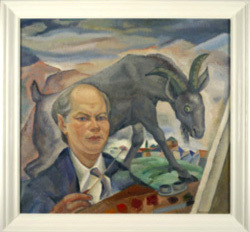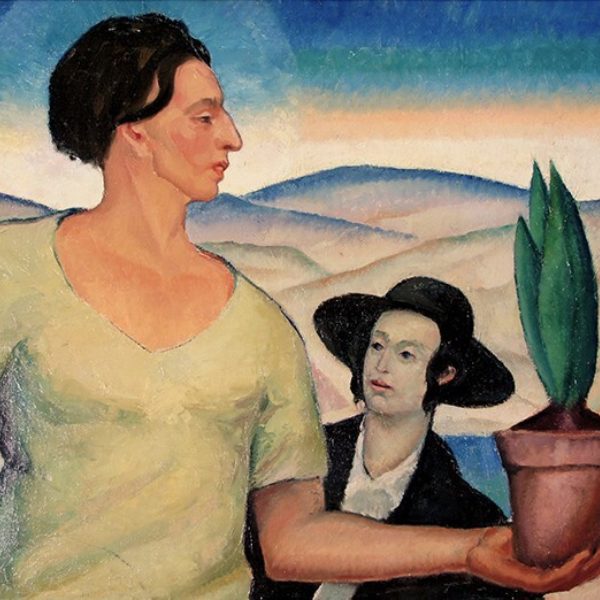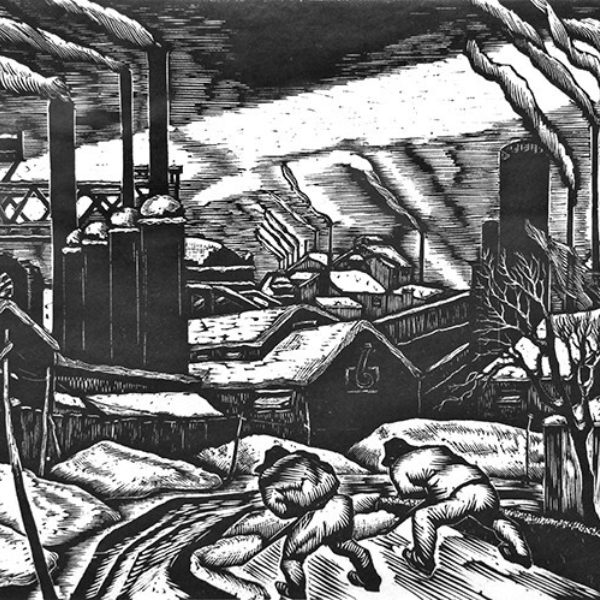
Todros Geller
b. 1889, Vinnitza, Ukraine, Russia - d. 1949, Chicago, IL
Todros Geller studied art in Ukraine as a teenager, and by the time he emigrated to Canada in 1906, he was prepared to enroll in the Ecole d’art in Montreal. He worked in Canada as a photographer, traveling across the country but in 1913 he married, and by 1918 had moved to Chicago, where he began studying at the School of the Art Institute (SAIC) while working at night. He entered the school at an opportune moment. The Ashcan School artist George Bellows, followed by Randall Davey, were visiting professors in 1919–20, and Geller chose to study with Bellows, who inspired the generation of students who formed the core of the modernist movement in Chicago. Bellows encouraged students to follow their own inclinations, to break free from artificial rules and restrictions, and advocated a gospel of democracy. Graduating in 1922, Geller was already teaching at the Jewish People’s Institute (JPI, a community center located in the heavily Jewish west side of Chicago), and quickly began exhibiting his work.
In 1926, L. M. Stein published what became a wildly popular portfolio of woodcuts titled Yiddish Motifs, representing typical Jewish religious and occupational themes; the print run of 150 sold out within three weeks. Geller used the proceeds to finance a trip to explore and document the history of Jewish art, traveling to Paris, where he met Chagall; England, where he studied medieval manuscripts; Prague, where he visited old synagogues; and ultimately Palestine, where he found both ancient art and contemporary inspiration, basing many works of art on his experiences there, including the Untitled (Two Men) painting in this collection. This image of the modern pioneer holding a plant before the fertile landscape while a Hasidic man looks on is typical of Geller’s mature work in its contrast of the new world and the traditional one, a theme he addressed repeatedly. The brilliant color and simple flattened composition also show his engagement with the modernist modes flourishing in Chicago at the time. The trip also inspired the print portfolio Palestinian Motifs Cut in Wood (1930), which reflect an interest in modernism, particularly in the flattened, angular shapes and avoidance of traditional perspective in favor of a more abstract balance of forms, and provided him with subjects that he reworked in various media over a number of years.
He returned from Palestine with a trove of knowledge of the history of Jewish art, and initiated an effort to establish a Museum of Jewish Art—the first anywhere, which he remained committed to for the rest of his life. He organized an exhibition at the JPI in 1928 to introduce people to the rich heritage of Jewish art that was not widely known, even in the Jewish community. The show traveled and so did Geller, lecturing and educating people in Yiddish culture and Jewish Nationalism—which, to him, was part of the liberation of all people in the world. His commitment to social justice was also an enduring aspect of his work. He contributed to portfolios of prints to benefit the Spanish Civil War published by the Chicago section of the American Artists’ Congress, For Spain and Liberty; and A Gift to Birobidjan, donated by Chicago Jewish artists to raise money for settlers in the area that the Soviet Union had designated an autonomous Jewish homeland.
Geller was active in Chicago’s Jewish community, a founding member of Around the Palette (a Jewish artists group later known as the American Jewish Art Club), and served as supervisor of art for the Board of Jewish Education and director of art for the College of Jewish Studies (now the Spertus Institute of Jewish Studies). He created many works with Jewish themes, and created decorative objects ranging from ritual objects to large stained glass window designs for synagogues all over the U.S. and in Canada. He executed set designs for the Yiddish theater, book illustrations, and yearbook designs for Jewish organizations, and created logos for a number of schools and institutions.
His versatility also extended to his subject matter. While he was known as the “Dean of Chicago Jewish artists,” he also addressed secular subjects in his paintings, prints, and book illustrations. These subjects ranged from voluptuous nudes to urban scenes done in the Cubist-inspired geometric mode known as Precisionism. He maintained a studio at 59 East Adams, which he shared with Emil Armin and later Belle Baranceanu. In the 1930s, he was employed as a printmaker on the Illinois Arts Project, one of the government supported art programs during the Depression. The work he produced for the projects include new imagery as well as reworkings of themes that had occupied him for years, and include numerous images dedicated to the issues of social justice that he addressed throughout his career.
Susan Weininger
References
Bulliet, C. J. “Artists of Chicago, Past and Present: Todros Geller.” Chicago Daily News, April 24, 1937.
Geller, Todros, Papers. Spertus Institute of Judaica, Chicago.
Todros Geller: Memorial Program and Exhibition. Chicago: Board of Jewish Education and the American Jewish Arts Club, 1949.

